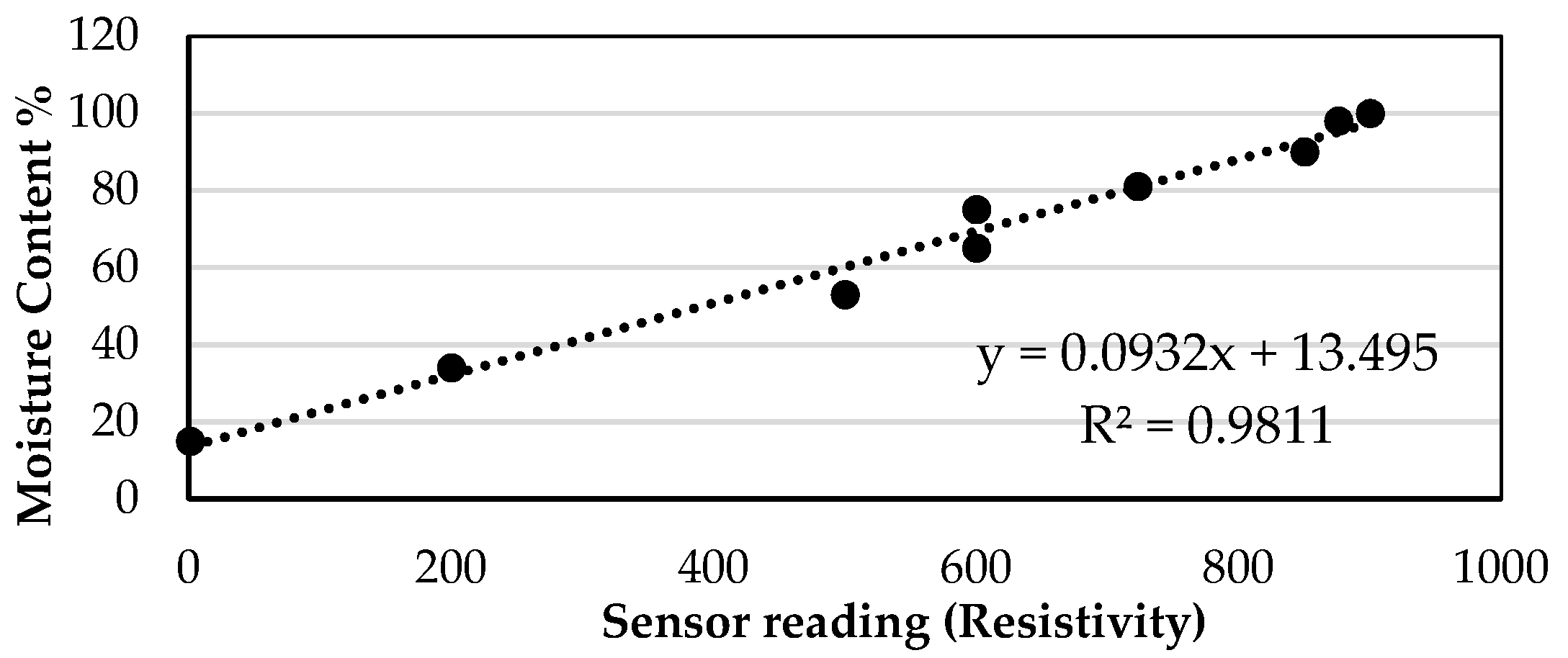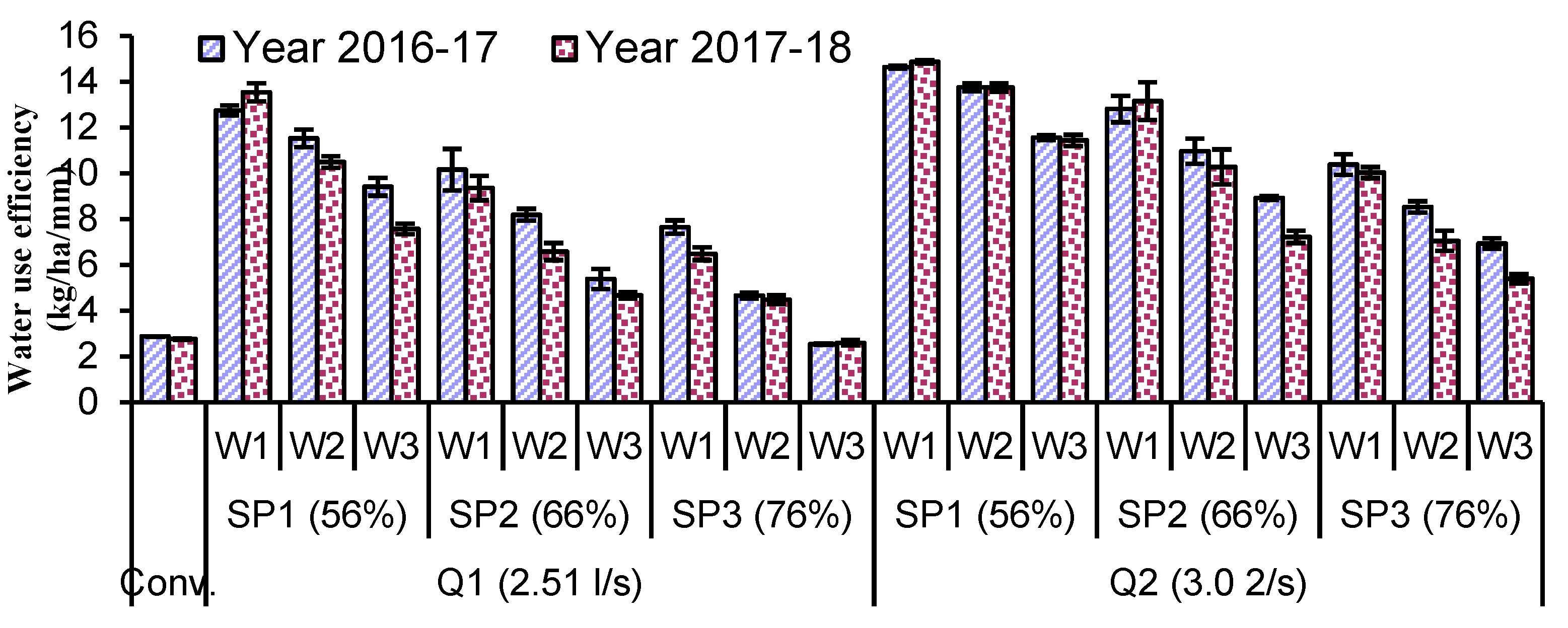Application of Sensor-Based Precision Irrigation Methods for Improving Water Use Efficiency of Maize Crop †
Abstract
:1. Introduction
2. Materials and Methods
2.1. Experimental Site
2.2. Hydraulic Simulation Model of Surface Irrigation System
2.3. Model Calibration
2.4. Experimental Design in WinSRFR
2.5. Water Use Efficiency
3. Results and Discussion
3.1. Soil Chemical Analysis
3.2. Moisture Sensors Calibration
3.3. WinSRFR Hydraulic Simulations
3.4. Plant Growth Parameters for Maize
3.5. Water Use Efficiency
4. Conclusions
Author Contributions
Funding
Institutional Review Board Statement
Informed Consent Statement
Data Availability Statement
Conflicts of Interest
References
- Falkenmark, M. The massive water scarcity now threatening Africa: Why isn't it being addressed? Ambio 1989, 18, 112–118. [Google Scholar]
- Alam, S. Globalization, poverty and environmental degradation: Sustainable development in Pakistan. J. Sustain. Dev. 2010, 3, 103. [Google Scholar] [CrossRef]
- Frater, F. Development of an optimisation framework for the investigation of multiple water stores. In Engineering: Theses and Dissertations; University of Canterbury: Christchurch, New Zealand, 2022. [Google Scholar]
- De Villiers, M. Water: The Fate of Our most Precious Resource; Houghton Mifflin Harcourt: Boston, MA, USA, 2001. [Google Scholar]
- Wade, R. The system of administrative and political corruption: Canal irrigation in South India. J. Dev. Stud. 1982, 18, 287–328. [Google Scholar] [CrossRef]
- Gillies, M.H.; Foley, J.P.; McCarthy, A.C. Improving surface irrigation. In Advances in Agricultural Machinery and Technologies; CRC Press: Boca Raton, FL, USA, 2018; pp. 225–261. [Google Scholar]
- Bautista, E.; Schlegel, J.L.; Strelkoff, T.S. WinSRFR 4.1-User Manual; USDA-ARS Arid Land Agricultural Research Center: Maricopa, AZ, USA, 2012. [Google Scholar]
- Centritto, M.; Loreto, F.; Massacci, A.; Pietrini, F.; Villani, M.C.; Zacchini, M. Improved growth and water use efficiency of cherry saplings under reduced light intensity. Ecol. Res. 2000, 15, 385–392. [Google Scholar] [CrossRef]
- Alloway, B.J. Soil factors associated with zinc deficiency in crops and humans. Environ. Geochem. Health 2009, 31, 537–548. [Google Scholar] [CrossRef] [PubMed]
- Thabet, A. Optimizing the Irrigation Performance of Raised Bed Wheat Using the WinSRFR Model. Master's thesis, Alexandria University, Alexandria, Egypt, 2022. [Google Scholar] [CrossRef]


Disclaimer/Publisher’s Note: The statements, opinions and data contained in all publications are solely those of the individual author(s) and contributor(s) and not of MDPI and/or the editor(s). MDPI and/or the editor(s) disclaim responsibility for any injury to people or property resulting from any ideas, methods, instructions or products referred to in the content. |
© 2023 by the authors. Licensee MDPI, Basel, Switzerland. This article is an open access article distributed under the terms and conditions of the Creative Commons Attribution (CC BY) license (https://creativecommons.org/licenses/by/4.0/).
Share and Cite
Aslam, M.A.; Cheema, M.J.M.; Saleem, S.; Basit, A.; Hussain, S.; Waqas, M.S. Application of Sensor-Based Precision Irrigation Methods for Improving Water Use Efficiency of Maize Crop. Environ. Sci. Proc. 2022, 23, 38. https://doi.org/10.3390/environsciproc2022023038
Aslam MA, Cheema MJM, Saleem S, Basit A, Hussain S, Waqas MS. Application of Sensor-Based Precision Irrigation Methods for Improving Water Use Efficiency of Maize Crop. Environmental Sciences Proceedings. 2022; 23(1):38. https://doi.org/10.3390/environsciproc2022023038
Chicago/Turabian StyleAslam, Muhammad Abubakar, Muhammad Jehanzeb Masud Cheema, Shoaib Saleem, Abdul Basit, Saddam Hussain, and Muhammad Sohail Waqas. 2022. "Application of Sensor-Based Precision Irrigation Methods for Improving Water Use Efficiency of Maize Crop" Environmental Sciences Proceedings 23, no. 1: 38. https://doi.org/10.3390/environsciproc2022023038
APA StyleAslam, M. A., Cheema, M. J. M., Saleem, S., Basit, A., Hussain, S., & Waqas, M. S. (2022). Application of Sensor-Based Precision Irrigation Methods for Improving Water Use Efficiency of Maize Crop. Environmental Sciences Proceedings, 23(1), 38. https://doi.org/10.3390/environsciproc2022023038









